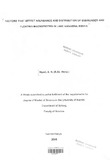| dc.description.abstract | The present study was conducted in Lake Naivasha (0° 45’S, 36° 20’E), a fresh water lake, which occupies a closed basin more or less circular in shape with no apparent outflow.
Lake Naivasha is relatively small with an area of about 100 km2 (Harper, 1999). The lake is located in the eastern arm of the Great Rift Valley. Three rivers, the Malewa (1730 km2, watershed), the Gilgil (420 km2, watershed) and Karati (135 km2, watershed) enter the lake in the northern part in a delta mainly covered by the giant sedge, Cyperus papyrus L.
A preliminary study was carried out in the month of February 2003 with an aim of familiarizing with the study area. The accessibility of the various points of the lake was assessed. A total of eight points were established considering the absence or presence of the target groups of macrophytes, the lake morphometry, main river inlets, depth and the riparian human activities of the lake among other factors. Hence, the sampling areas were established to provide a range of sites having different characteristics. The sites were located using a hand held Global Positioning System (GPS), Garmin 12XL. A study was carried out to find out the current status of Lake Naivasha floating and submerged macrophytes. The species abundance and distribution within the lake were evaluated. The study was carried out from the month of February to July 2003.
The rake-sampling method developed by Jessen and Lound (1962) was applied in sampling of submerged macrophytes. Sampling of floating vegetation was carried out using quadrats at the eight sample sites. Within an area measuring 10 by 30m, 1 by 1m quadrats were thrown randomly six times and the species present recorded, that is, both the floating and associated species.
Water physico-chemical parameters were also studied. Secchi depth measurements were all below 100cm in all stations located in the Main Lake and they did not exceed 150cm at the Crescent Island Lake. Spatial variation of water clarity differed significantly (one-way ANOVA: F7, 40=51.91; p<0.05). Highest mean concentration of soluble reactive phosphorus was registered at Malewa River Inlet sampling site. A concentration mean of 29±6.9pgL'1 was recorded at Malewa River Inlet while Crescent Island Lake site had the lowest mean of 15±3.6pgL'1. However, there was no significant difference in mean concentrations of soluble reactive phosphorus in the eight stations (one-way ANOVA: F7, 40=1.23; p>0.05). Malewa River Inlet sampling site had on average the highest concentration of nitrates (225±102pgL'1) while Crescent Island Lake had the lowest amounts (34±12pgL‘1). For measurements on conductivity, Malewa River Inlet sampling site had the lowest mean conductivity (168±47pScm'1) while Crescent Island Lake had the highest (317±15pScm'1). Of the eight sample sites, Crescent Island Lake had highest substratum gradient followed by Hippo point.
The prevailing wind direction was found to be mostly southeasterly. Southeasterlies constituted 51% of the total number of times the direction was determined. Southerlies made up 27% with a proportion of 15% blowing to the west. The soil textural characteristic of sediments was investigated for the established stations. Highest amounts of sand were found at Hippo point (93-97%) and Crescent Island Lake (89-91%) while Kasarani (10-27%) had the lowest proportion. Two major floating species were found to occur: Eichhornia crassipes (Mart.) Solms and Salvinia molesta Mitchell. Sample sites such as Central Landing Beach, Malewa River Inlet and Kasarani had the highest percentage frequencies of E. crassipes (100%) followed by Sher Agencies which had 93.3% frequency. Kasarani had the highest amount of S. molesta (61.1%) while Crescent Island Lake and Central Landing Beach recorded none. Hippo point and Kamere had almost the same amount of S. molesta. Nymphaea sp a floating-leaved plant, was found in small quantities (0.3%).
Submerged aquatic macrophytes recorded were: Potamogeton octandrus Poir, Potamogeton pectinatus L., Najas horrida Magn, Potamogeton schweinfurthii A, Ceratophyllum demersum L. and Nitella sp. with percentage frequencies of 15.2%, 12.2%, 12%, 3.2%, 1% and 0.8% respectively. There was significant difference in distribution and abundance of both floating and submerged macrophytes between the sample stations at 0.05 significance level.
Factors studied in relation to their influence on aquatic macrophytes were: nature of substratum, wind direction, pH, Secchi depth, nutrients, lake bed slope and depth. These factors were found to affect the distribution and abundance of the macrophytes importantly. Wind direction was found to be the most important environmental factor influencing the abundance and distribution of free-floating macrophytes in Lake Naivasha. The percentage sand was also significant (p<0.05, Regr. coeff. = -0.749) in influencing the abundance and distribution of free-floating macrophytes. On the other hand, the nature of substratum and slope affected the location and abundance of submerged plants within the lake significantly. For example, the proportion of sand in the sediments together with slope explained 86.3% of the total plant variation encountered in abundance of P. octandrus. | en_US |



